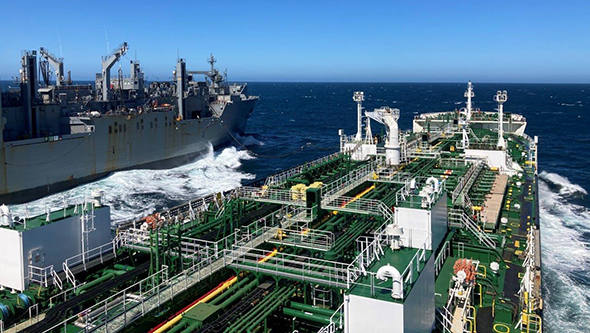| Print | Close Window | AMO Currents - Posted: August 20, 2021 |
MSC conducts underway replenishment operations with tanker Empire State off the coast of Southern California

Off the coast of Southern California, the M/T Empire State (T-AOT 5193), which is operating under long-term charter to Military Sealift Command, conducted connected at-sea refueling operations (CONSOL) with three MSC Combat Logistics Fleet ships July 11 to 14. The Empire State conducted five CONSOL events with MSC dry cargo ammunition ships USNS Matthew Perry (T-AKE 9) and USNS Washington Chambers (T-AKE 11), and the MSC fleet replenishment oiler USNS Henry J. Kaiser (T-AO 187), delivering nearly 4 million gallons of fuel.
Military Sealift Command photo: Sarah Burford
The following article was published in Sealift, the monthly newsletter of Military Sealift Command. American Maritime Officers represents all licensed officers on the tanker Empire State.
Off the coast of Southern California Military Sealift Command's long-term chartered motor tanker ship Empire State (T-AOT 5193) conducted connected at-sea refueling operations (CONSOL) with three MSC Combat Logistics Fleet (CLF) ships July 11-14.
Empire State conducted five CONSOL events with MSC dry cargo ammunition ships USNS Matthew Perry (T-AKE 9) and USNS Washington Chambers (T-AKE 11) and the MSC fleet replenishment oiler USNS Henry J. Kaiser (T-AO 187), delivering nearly 4 million gallons of diesel ship fuel.
CONSOLs with tankers is nothing new for MSC. MSC reintroduced the ability to conduct tanker to oiler CONSOLS-at-sea in 2015. In the 1980s and 1990s, MSC chartered Champion Class tankers (T5 tankers) UNREPing Navy oilers was common place, especially in the Navy's 5th Fleet area of operations. With the switch to privately-owned/Navy-chartered tankers, Navy oilers refueling at Navy owned fuel piers became the favored process. Civilian tanker ships, such as Empire State, still maintained the ability to fuel at sea; the demand for fuel consolidation (CONSOL) at sea declined. Reintroducing the technology is a way to utilize a flexible platform that allows MSC to operate world-wide in a variety of missions.
For the Master on Empire State, the CONSOLs were a welcomed change of pace for the crew of the 600-foot tanker. As he explained, transferring fuel at-sea has a different set of challenges then taking fuel from a commercial fuel pier, or from a fuel buoy, where harbor pilots maneuver the tankers into place. At-sea, the maneuvering and ship handling fall to the ships' masters. As the on station ship, Empire State provided coordinates for the CLF ships, ensuring everyone was at the rendezvous point on time.
"The biggest challenge we face when doing a CONSOL at-sea is good communication," explained Capt. Andrew Miller, Empire State's civilian master. "MSC always does a great job of working with us. The team at MSCPAC (Military Sealift Command Pacific) and the CLF crews are professional operators, so there is always a lot of good communications across the team. It really makes a difference when we are doing an operation like this."
While CONSOL operations with MSC have happened several times a year, since that first back in 2015, what makes this different is that three separate CLF ships received fuel over five separate fueling operations. In the past, one ship would work with the tanker ship. This meant the evolutions had to be timed so that one ship could receive fuel and depart, leaving time for Empire State to reach the rendezvous point for the second ship. In one case, this was about an hour from the time one ship broke away and departed, and the second ship was in position alongside the tanker.
"We have a lot more experience since the first time we did a CONSOL with a CLF ship," said Miller. "The crew is so much more proficient now, so things went a lot smoother. I attribute a lot of that to good communication with my crew, but also between us and the other ships."
Taking fuel from a tanker ship like Empire State allows MSC ships, to stay at sea to refuel, rather than to come into a commercial fuel pier in port. Originally, the concept was developed to keep United States Ships out of foreign ports during times of conflict, but during the COVID-19 pandemic lock-downs, the technology provided a way for MSC ships to stay underway for extended periods, which ensured the crews remained free from the virus, while still having the ability to receive fuel and service their Navy customers.
"Working with the Kaiser and Perry is a totally professional operation," said Miller. "I get great support from them and from MSCPAC's Operations Department. It's been a great experience for us."
| Copyright © American Maritime Officers, All Rights Reserved |